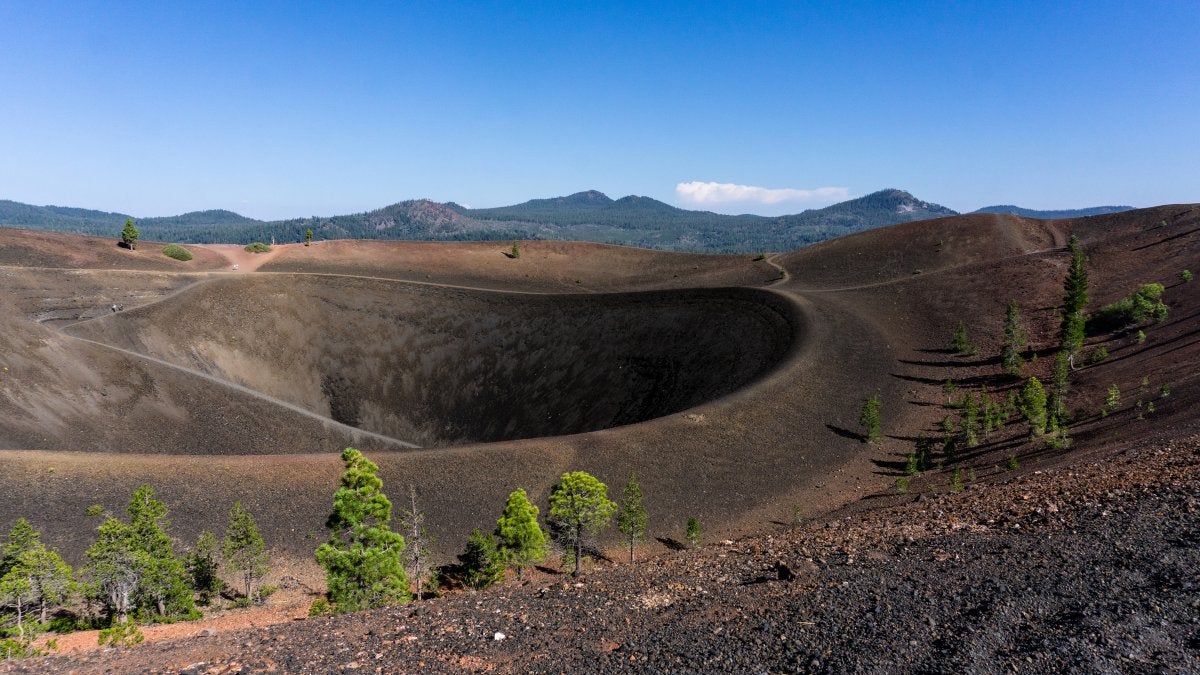No products in the cart.
Outdoor Adventure
Teetering on the Edge of Volcanoes
62 Parks Traveler started with a simple goal: to visit every U.S. national park. Avid backpacker and public lands nerd Emily Pennington saved up, built out a tiny van to travel and live in, and hit the road. The parks as we know them are rapidly changing, and she wanted to see them before it’s too late.
Pennington is committed to following CDC guidelines during the COVID-19 pandemic to ensure the safety of herself and others. She’s visiting new parks while closely adhering to best safety practices.
Out of the corner of my eye, I could make out the hazy, ragged outline of Lassen Peak as I sunk my boots into black volcanic sand, my breath labored in the warm sun. The hike up Cinder Cone, I had been warned, was no walk in the park, but the top, at 6,906 feet, promised exceptional views into Northern California’s Lassen Volcanic National Park in the southern Cascade Range. After more than 800 vertical feet of uphill on the dormant volcano’s steep slope, my friend, Ave, and I topped out on the crater’s edge. My heart skipped a beat.
Below me, surrounding the cone, was an enormous inky expanse aptly named the Fantastic Lava Beds. Swirls of once molten rock carved their way across the mountainous landscape, opening up into acres of multicolored sand—the Painted Dunes. I had spent only three hours in the park and already felt sated. I wondered what magic the next day would bring.
After a full night’s sleep, we both felt like warriors, so we sped off across the park’s main road to summit its namesake mountain, Lassen Peak. At 10,457 feet, this prominent volcano is a hiker’s dream: a 2,000-foot hamstring-busting romp through wildflowers and 100-year-old eruption zones that ends with a mild scramble up to panoramic views of forests, hillsides, and many sparkling sapphire lakes.
After a two-hour hike, at the top we giddily ate lunch and took far too many selfies, gazing down into the toothy mess of rock that forms the mountain’s central crater. Later, we stripped down to our skivvies and plunged into Lake Helen to cool down from the July heat, watching a horde of puffy white clouds roll in on the breeze.

We couldn’t leave without checking out at least one of the park’s eight hydrothermal areas, so we closed out our second day with a three-mile trek through Bumpass Hell. The sharp smell of sulphur singed my nose hairs as we trotted across the boardwalk, gazing out at steaming fumaroles, brilliant aquamarine hot springs, and burbling mudpots. It was like Yellowstone in miniature.
In 1885, when Yellowstone was newly created, a marketing team used an Alice in Wonderland motif to promote the park’s seemingly magical landscape. Now, more than a century later, I feel that sentiment could just as easily be applied to Lassen Volcanic. It’s an often overlooked area full of bizarre rock features, metamorphic leftovers, and historic trails, and with only an eighth of Yellowstone’s annual visitation, it’s ripe for discovery.
“I can’t believe I’ve lived in California for 15 years and have never been here!” I shouted to Ave as we skipped through amethyst lupine fields on the way back to our cars. I didn’t understand why this was such a sleeper park. The killer hiking, boiling steam vents, and the fact that 17 miles of the Pacific Crest Trail run through Lassen’s borders combine to make it one of California’s best-kept secrets. Just don’t tell anyone, OK?
62 Parks Traveler Lassen Volcanic Info
Size: 106,372 acres
Location: Northern California
Created In: 1907 (national monument), 1916 (national park)
Best For: Hiking, geology, backpacking, car camping, geothermal features, stargazing.
When to Go: Due to its high elevation—the park’s lowest point is a breezy 5,650 feet—most visitors arrive in summer (34 to 85 degrees Fahrenheit) and fall (21 to 78 degrees). The snow is still melting in spring (16 to 70 degrees), and the park can receive as much as 30 feet of snow in winter (13 to 52 degrees).
Where to Stay: Lassen Volcanic offers excellent car camping options for those not looking to backpack. Butte Lake, near Cinder Cone, is a more rustic option situated amid towering pine trees. Manzanita Lake, on the park’s west side, is larger, more developed, and more RV-friendly.
Mini Adventure: Hike to Bumpass Hell. This moderate three-mile hike takes visitors past phenomenal views of Lassen Peak, across lush alpine meadows, and onto a boardwalk that meanders through an active hydrothermal basin. Visitors can explore hot turquoise pools, hissing sulfuric vents, and boiling mudpots from the safety of the trail.
Mega Adventure: Summit Lassen Peak. Any serious peakbagger won’t be able to resist the steep five-mile (round-trip) trail to the top of this massive volcano. A series of eruptions lasting from 1914 to 1917 helped upgrade the park from a national monument in 1916. From the summit, hikers can gaze out at Cinder Cone, Eagle Peak, and the Devastated Area, a rocky expanse that highlights the sheer power of the mountain’s most recent blow. Best attempted late summer through early fall.
Lead Photo: Emily Pennington

